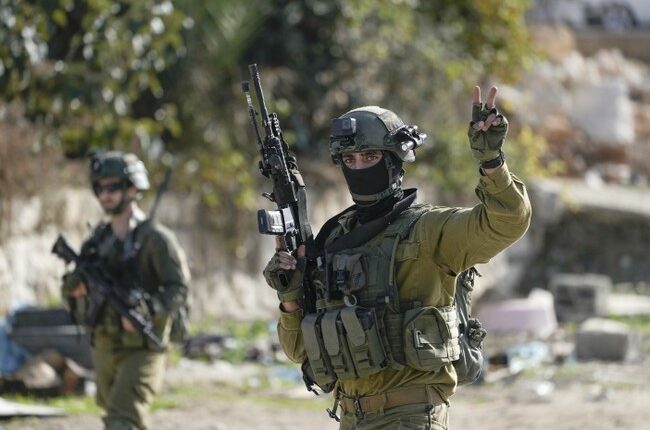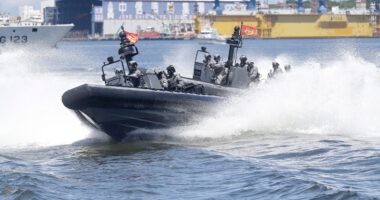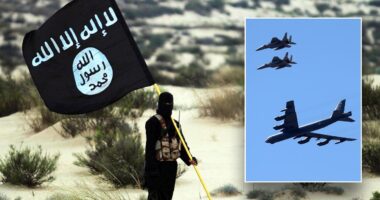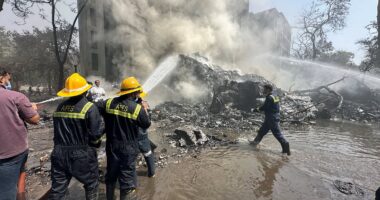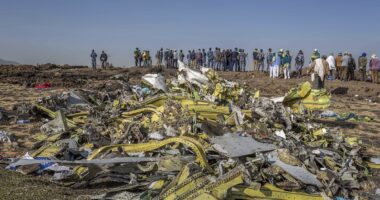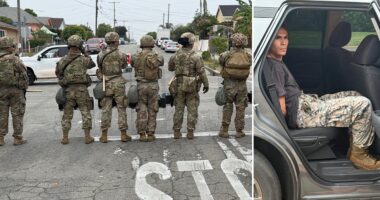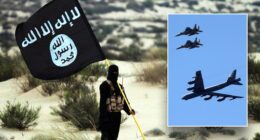
An audacious Israeli commando mission inside Syria, authorized by Bashar Assad, aimed at obliterating an Iranian weapons factory producing missiles for Hezbollah meant to be fired into Israel. This operation also posed as a trial for the possible strategy of jeopardizing all of Iran’s nuclear sites.
The bold maneuver took place on the night spanning September 8-9, as a specialized unit of 120 Israeli Air Force Shaldag commandos arrived in CH-53 helicopters to carry out the attack on an underground facility in the Masyaf region of Syria, situated west of Hama. The method employed involved a mix of landing techniques and swift rope descents.
This is a video of US Marines fast roping from the same type of helicopter used in the Israeli operation.
Located over 125 miles away from Israel’s border and around 30 miles from Syria’s western shoreline, the targeted site was strategically chosen. In a bid to bypass Syria’s air defense network, the CH-53 helicopters made their approach from the Mediterranean sea route. Given the CH-53’s operational span of about 430 miles, air refueling was essential for the mission. A detailed 3-D rendition of the site provides insight into the mission’s scale and the challenges faced during its execution.
An inside look at the Iranian underground facility Maysaf in Syria:
Attached is a 3D model of the entire compound, and a camera footage of the the soldiers that raided the facility, used for manufacturing precision missiles. pic.twitter.com/9hnibz6kS9
— ((🆆3⃣🅱🆂🜃🅶3⃣)) 🇮🇱 I Stand with Israel! 🇮🇱 (@w3bsag3) January 3, 2025
Because the last Iranian missile factory in Syria was smashed flat by an Israeli airstrike in 2017, the Iranians built this one to be bombproof.
The site that Iran constructed was 70-130 meters (230-430 foot) underground and thus virtually impossible to destroy from the air.
Iranian digging into the mountain at the research center began in late 2017. The IDF said it had intelligence on the facility from the moment construction began.
…
Along the horseshoe were at least 16 rooms housing the production line for the missiles, from planetary mixers for the rocket fuel to missile body construction and paint rooms.
The facility was not yet completely active when Israel launched its operation against it, but according to the military, it was at the final stages of being declared operational by Iran. At least two missiles had been successfully manufactured as part of testing, and rocket engines were already being mass produced.
The raid was reported at the time in Syrian opposition media and picked up by some Western outlets, but the details were only revealed this week.
Charles Lister of the Middle East Institute think tank, who has closely monitored developments at the site based on people in Syria and abroad and local news reports, said the Israeli raid was directed at a factory inside a mountain that develops missiles and rockets.
That facility, he said, is controlled by Iran’s Islamic Revolutionary Guard Corps, a U.S.-designated terrorist organization, and is part of a larger military complex that is managed by Assad’s regime in Syria.
Israel has accused Iran of using a scientific research center in military sites near Masyaf to develop weapons and missiles intended for its aligned regional militias, including Hezbollah, analysts say.
DECLASSIFIED: In September 2024, before the fall of the Assad Regime, our soldiers conducted an undercover operation to dismantle an Iranian-funded underground precision missile production site in Syria.
Watch exclusive footage from this historic moment. pic.twitter.com/s0bTDNwx77
— Israel Defense Forces (@IDF) January 2, 2025
IDF Reveals: Over 100 special unit fighters raided and destroyed an underground facility producing precision missile in a special Air Force operation in Masyaf, deep inside #Syria last September.
The targeted facility, funded and supported by Iran, and served to arm its proxies… pic.twitter.com/bOcYGr31Sp
— 🎗️Walid Abu Haya 🇮🇱 (@WalidAbuHaya1) January 2, 2025
The Israelis also revealed a surprising level of tactics, techniques, and procedures that were either a blunder or calculated to send a message.
The four helicopters then flew away to other positions in the area, where they landed and waited for over two hours for the 100 commandos to carry out their mission.
The 20 Unit 669 members, still on board the choppers, were to spring into action if any of the commandos were wounded. The plan was to treat any wounded soldiers, but not to leave until the end of the mission. Therefore, Unit 669 brought along additional medical equipment to act as a makeshift hospital in the event of an injury.
At the facility, a first team of commandos began to secure the area while a second team advanced toward the entrance, killing two guards. Another team set up on a nearby hill, from which they flew a small drone to observe the raid and eliminate anyone approaching the facility.
…
At the mission’s 50-minute mark, the first team of commandos managed to break through one of the entrances — the one used for logistics and to reach the offices. The soldiers entered the site and reached the two production entrances — the horseshoe — opening them using forklifts that were inside the facility. The IDF had known in advance that the facility had such equipment, and had sent some of the commandos participating in the raid to get forklift certification.
At the same time, another team of commandos carrying explosives arrived at the entrances. The troops had brought a quad bike with them in one of the choppers to enable them to quickly move to and through the facility to plant the explosives.
At the same time, fighter jets continued to pound the surrounding region to prevent dozens of people identified on the ground — apparently Syrian soldiers — from approaching. In all, 49 munitions were used by IAF aircraft during the raid.
After the commandos had rigged up all the explosives — around 300 kilograms’ (660 pounds’) worth — to a remote detonator planted at the entrance to the site, all 100 evacuated to the initial landing site. The helicopters flew in from their waiting positions, picking up the soldiers after two and a half hours on the ground.
So why the big media rollout on a raid that happened three months ago? I think the first reason is to impress the locals with Israeli military capabilities. This media event, in addition to the happenings on the ground, goes a long way toward undoing any damage to the psychological dominance Israel has established over its enemies since 1948 by the October 7, 2023 massacre of Israeli civilians. The second reason is to send a message to the Iranians that you can’t dig a facility deep enough to get away from the IDF if they want you.
The attack at Masyaf looked a lot like a rehearsal for an attack on Iran’s nuclear facilities. In the aftermath of the rout of Assad’s forces and the fall of the Ba’athist regime, Israel carried out a punishing campaign of air attacks on Syrian radar, fighter bases, and air defense sites. So much so that it is fair to say that Syria is incapable of knowing who is using its airspace, much less contesting that usage; see .
While Operation EAGLE CLAW, the attempted rescue of US hostages held by Iran in April 1980, was a humiliation of American arms, the same basic plan is imminently viable to take out Iran’s nuclear weapons research and production facilities. The destruction of Syrian air defenses and early warning systems means a relatively large Israeli force could seize a foothold within helicopter range of the target area and, under the cover of airstrikes, penetrate Iranian nuclear facilities and destroy them.
And we can never ignore that third possible reason. Given the obvious inferences from the Masyaf raid, the Iranians may very well react by reinforcing their nuclear facilities and, in the process, reveal nuclear sites that were previously unknown.
